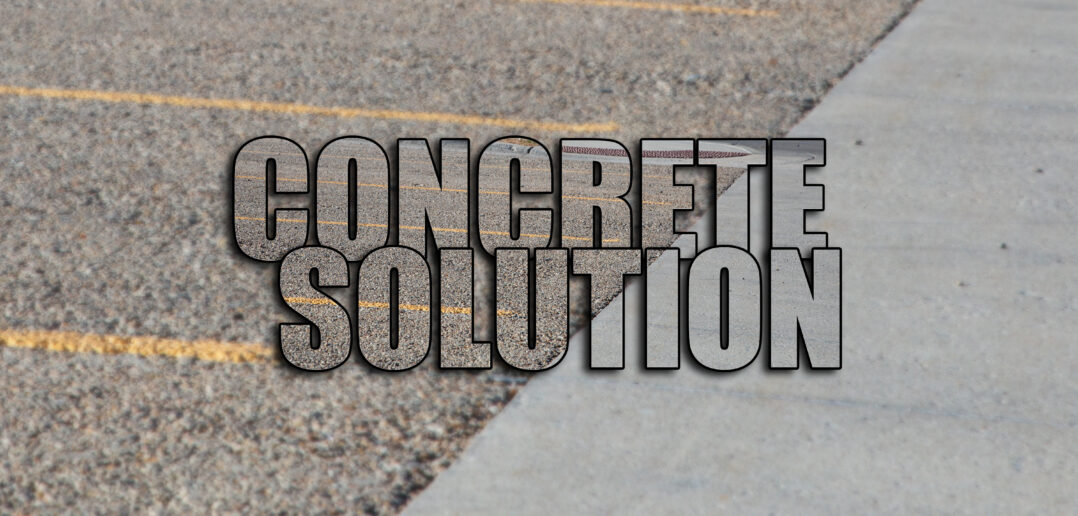| story by | |
| photos by | Steven Hertzog |
| OPEN A PDF OF THE ARTICLE |
Technology used to develop a new kind of concrete as an alternative to help manage runoff problems.

Concrete Solution
Concrete has been with humans for as long as people can remember. The first instance of it being used in a building dates back to the Greeks between 1400 and 1200 B.C. Fast-forward to 2021, and concrete is used in everything from roads and buildings to benches and sidewalks. These days, environmental issues are also a concern, and activists have levied their eyes on concrete. During rainstorms, runoff from the grass, trash and concrete travels into storm drains, which lead, at least in Lawrence, to the Wakarusa and Kansas Rivers.
There’s a new type of concrete being used to try and alleviate this runoff problem: pervious concrete. Instead of allowing water to pool and take dirt and trash into the stormwater, pervious concrete allows the water drain directly into the storm system by absorbing into the concrete (which is a bunch of rocks compressed together and glued with paste) and either evaporating directly from the concrete or pooling into an underground storage place. Trade industry websites note it can be used for a variety of applications and can replace traditional concrete.
The Kansas Department of Transportation (KDOT), one of the biggest users of concrete and asphalt that could be replaced with pervious concrete, does not use this type of concrete. Rick Barezinsky, KDOT assistant bureau chief of materials, says this type is much better suited for urban areas.
“Urban areas benefit the most from pervious concrete. Constructing sidewalks and parking lots with pervious concrete provides a path for the rainwater to percolate into the groundwater, often eliminating the need for retention ponds where real estate is expensive,” Barezinsky explains. “This also helps property owners comply with the EPA stormwater regulations.
“Using pervious concrete as the surface on highways is typically not done across the U.S. because the concrete is so porous, it is not as durable as traditional concrete pavement,” he continues. “Raveling of the surface is a common distress associated with pervious concrete. There is also concern that it does not provide the same structural support as conventional PCCP [Portland Cement Concrete Pavement] and, thus, pervious concrete is not recommended for high-volume traffic areas.”
Even though it is directed toward urban areas such as Lawrence, Porter Arneill, director of communications and creative resources at the City of Lawrence, says that while Lawrence governmental agencies are looking into the technology, it is not yet in use.
“The City hasn’t used pervious concrete in the past, but staff is exploring ways to use it where appropriate in the future to help address environmental issues and support green, sustainable growth,” Arneill explains.
Despite the scarcity of contractors and process of learning, there are notable examples of pervious pavement being used successfully. The University of Kansas’s Lot 54 is an example of green engineering using pervious concrete, the result of which is water being absorbed into the ground and fed to trees instead of running off into storm drains with dirt. Gary Mohr, project manager for planning and development who managed Lot 54 when it was being built, says the idea behind the lot was to filter the water to get rid of extra sediment and trash before it went either into storage or the stormwater drains.
“The idea was to detain and, in theory, filter stormwater runoff from that parking lot. That was to assist with overall stormwater management. Underneath the parking area, there are large, 5-foot-deep beds of gravel,” he explains. “We cut large pockets into the ground and filled them with gravel. The pervious pavement lets the water filter through that and down into that gravel, and then any overflow feeds out into tanks underground, and it feeds out gradually. In theory, it all infiltrates into the ground, so there’s no runoff.”
Pervious concrete, while helping with runoff by keeping it out of the storm drain, still traps some of the dirt. Mohr says that although they must bring a company with an industrial-sized vacuum pump to clean it out, it’s still beneficial.
“The idea of reducing stormwater runoff and the silt and the dirt that goes with it, in theory, that’s all filtering into the rock basins and not into the Wakarusa River, which is where all that water ends up in the city storm system,” he says. “It’s not the runoff, it’s the dirt and the material that’s in the runoff that’s bad for the environment. You have to have runoff [in some form], else you wouldn’t have rivers and streams.”

Concrete Solution
One of the problems for why this technology is not used more is cost. Trade industry websites say that although the first cost is more expensive, over time, it gradually gets less so factoring in general costs associated with maintenance and upkeep. However, Mohr says for a governmental entity like his, that doesn’t matter. The base cost of the concrete, Mohr explains, caused the cost of the project to balloon to over twice the original budget.
“No, we haven’t [used pervious concrete since]. It turned out to be extremely expensive. [Lot 54] was considerably over budget. The administration decided that it was important that they fund it, but we’ve not done pervious pavement again since that project just because of experience, I think, primarily.” he says. “Digging out that much subgrade and buying that much rock, that is all well over and above what you would normally do for a parking lot. It’s not just the pavement, it’s the whole process.”
There’s a maintenance aspect to it, too, Mohr notes. It can’t just be left alone.
“It’s a maintenance-intensive process because you have to continuously clean the dirt and silt out of that concrete. Parking and Transit works with Facilities to do so,” he says.
The lot is not entirely pervious concrete. Instead, the lot’s driving lanes are regular concrete, and the parking spaces are where the pervious concrete was laid. Mohr says that was intentional because the pervious concrete is not quite as durable as regular concrete.
“The driving lanes that get more traffic wouldn’t stand up with the pervious concrete. The only place that we put the pervious concrete was in the parking stalls, but that’s also the low part of each parking bay, and so the water is going to run to that area and then infiltrate,” he explains. “You’re going to have some runoff regardless, but the idea was that you were going to catch the majority of the parking surface by channeling it toward those low areas.”
It has been seven years since the lot was installed, and in that time, it has gotten a lot of good use.
“I think the jury’s still out,” Mohr says. “We’ll see how long that pervious concrete will hold up. In theory, it’s a good idea to detain the stormwater because it helps with not only filtering the runoff, but it also helps with the city storm system, which is overloaded in places. I think the theory is good, but I’m not 100% sold on pervious concrete.”
Despite its challenges, pervious concrete can be a useful piece of technological advancement. Homeowners looking to help reduce their environmental footprint can look into whether they should use it to help with runoff. Business owners wanting to be environmentally responsible when building a new parking lot have an option to help reduce stormwater runoff. Although the process of forming the concrete still needs to be perfected, it’s a new tool for environmentally friendly infrastructure. p
![]()




